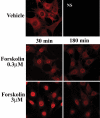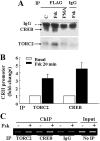Involvement of transducer of regulated cAMP response element-binding protein activity on corticotropin releasing hormone transcription
- PMID: 20080871
- PMCID: PMC2840689
- DOI: 10.1210/en.2009-0963
Involvement of transducer of regulated cAMP response element-binding protein activity on corticotropin releasing hormone transcription
Abstract
We have recently shown that phospho-cAMP response element-binding protein (CREB) is essential but not sufficient for activation of CRH transcription, suggesting the requirement of a coactivator. Here, we test the hypothesis that the CREB coactivator, transducer of regulated CREB activity (TORC), is required for activation of CRH transcription, using the cell line 4B and primary cultures of hypothalamic neurons. Immunohistochemistry and Western blot experiments in 4B cells revealed time-dependent nuclear translocation of TORC1,TORC 2, and TORC3 by forskolin [but not by the phorbol ester, phorbol 12-myristate 13-acetate (PMA)] in a concentration-dependent manner. In reporter gene assays, cotransfection of TORC1 or TORC2 potentiated the stimulatory effect of forskolin on CRH promoter activity but had no effect in cells treated with PMA. Knockout of endogenous TORC using silencing RNA markedly inhibited forskolin-activated CRH promoter activity in 4B cells, as well as the induction of endogenous CRH primary transcript by forskolin in primary neuronal cultures. Coimmunoprecipitation and chromatin immunoprecipitation experiments in 4B cells revealed association of CREB and TORC in the nucleus, and recruitment of TORC2 by the CRH promoter, after 20-min incubation with forskolin. These studies demonstrate a correlation between nuclear translocation of TORC with association to the CRH promoter and activation of CRH transcription. The data suggest that TORC is required for transcriptional activation of the CRH promoter by acting as a CREB coactivator. In addition, cytoplasmic retention of TORC during PMA treatment is likely to explain the failure of phorbolesters to activate CRH transcription in spite of efficiently phosphorylating CREB.
Figures







Comment in
-
TORC: a new twist on corticotropin-releasing hormone gene expression.Endocrinology. 2010 Mar;151(3):855-8. doi: 10.1210/en.2009-1503. Endocrinology. 2010. PMID: 20172974 Free PMC article. No abstract available.
Similar articles
-
Cyclic adenosine 3',5'-monophosphate responsive element binding protein phosphorylation is required but not sufficient for activation of corticotropin-releasing hormone transcription.Endocrinology. 2008 Jul;149(7):3512-20. doi: 10.1210/en.2008-0052. Epub 2008 Mar 27. Endocrinology. 2008. PMID: 18372325 Free PMC article.
-
Salt-inducible kinase is involved in the regulation of corticotropin-releasing hormone transcription in hypothalamic neurons in rats.Endocrinology. 2012 Jan;153(1):223-33. doi: 10.1210/en.2011-1404. Epub 2011 Nov 22. Endocrinology. 2012. PMID: 22109884 Free PMC article.
-
Stress induces parallel changes in corticotrophin-releasing hormone (CRH) Transcription and nuclear translocation of transducer of regulated cAMP response element-binding activity 2 in hypothalamic CRH neurones.J Neuroendocrinol. 2011 Mar;23(3):216-23. doi: 10.1111/j.1365-2826.2010.02101.x. J Neuroendocrinol. 2011. PMID: 21121974 Free PMC article.
-
CRH: the link between hormonal-, metabolic- and behavioral responses to stress.J Chem Neuroanat. 2013 Dec;54:25-33. doi: 10.1016/j.jchemneu.2013.05.003. Epub 2013 Jun 15. J Chem Neuroanat. 2013. PMID: 23774011 Review.
-
Regulation of somatostatin gene transcription by cyclic adenosine monophosphate.Metabolism. 1996 Aug;45(8 Suppl 1):4-7. doi: 10.1016/s0026-0495(96)90068-2. Metabolism. 1996. PMID: 8769368 Review.
Cited by
-
TORC: a new twist on corticotropin-releasing hormone gene expression.Endocrinology. 2010 Mar;151(3):855-8. doi: 10.1210/en.2009-1503. Endocrinology. 2010. PMID: 20172974 Free PMC article. No abstract available.
-
Salt-inducible kinase 1-CREB-regulated transcription coactivator 1 signalling in the paraventricular nucleus of the hypothalamus plays a role in depression by regulating the hypothalamic-pituitary-adrenal axis.Mol Psychiatry. 2024 Jun;29(6):1660-1670. doi: 10.1038/s41380-022-01881-4. Epub 2022 Nov 25. Mol Psychiatry. 2024. PMID: 36434056
-
Involvement of noradrenergic transmission in the PVN on CREB activation, TORC1 levels, and pituitary-adrenal axis activity during morphine withdrawal.PLoS One. 2012;7(2):e31119. doi: 10.1371/journal.pone.0031119. Epub 2012 Feb 15. PLoS One. 2012. PMID: 22355339 Free PMC article.
-
The Effect of Acute and Repeated Stress on CRH-R1 and CRH-R2 mRNA Expression in Pituitaries of Wild Type and CRH Knock-Out Mice.Cell Mol Neurobiol. 2018 Jan;38(1):163-169. doi: 10.1007/s10571-017-0556-3. Epub 2017 Oct 9. Cell Mol Neurobiol. 2018. PMID: 28993972 Free PMC article.
-
HPA axis responsiveness to stress: implications for healthy aging.Exp Gerontol. 2011 Feb-Mar;46(2-3):90-5. doi: 10.1016/j.exger.2010.08.023. Epub 2010 Sep 9. Exp Gerontol. 2011. PMID: 20833240 Free PMC article. Review.
References
-
- Aguilera G 1994 Regulation of pituitary ACTH secretion during chronic stress. Front Neuroendocrinol 15:321–350 - PubMed
-
- Dallman MF, Akana SF, Levin N, Walker C-D, Bradbury MJ, Suemaru S, Scribner KS 1994 Corticosteroids and the control of function in the hypothalamo-pituitary-adrenal (HPA) axis. Ann NY Acad Sci 746:22–28 - PubMed
-
- Munck A, Naray-Fejes-Toth A 1994 Glucocorticoids and stress: permissive and suppressive actions. Ann NY Acad Sci 746:115–130 - PubMed
-
- Herbert J, Goodyer IM, Grossman AB, Hastings MH, de Kloet ER, Lightman SL, Lupien SJ, Roozendaal B, Seckl JR 2006 Do corticosteroids damage the brain? J Neuroendocrinol 18:393–411 - PubMed
-
- McEwen BS, Brinton RE, Sapolsky RM 1988 Glucocorticoid receptors and behavior: implications for the stress response. Adv Exp Med Biol 245:35–45 - PubMed

